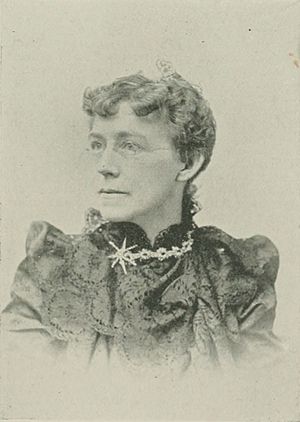Margaret Cleaves facts for kids
Quick facts for kids
Margaret A. Cleaves
|
|
|---|---|
 |
|
| Born | November 25, 1848 Columbus City, Iowa, U.S.
|
| Died | November 7, 1917 (aged 68) Mobile, Alabama, U.S.
|
| Nationality | American |
| Education | M.D. |
| Alma mater | University of Iowa Medical Department |
| Known for | pioneer of electrotherapy and brachytherapy |
Margaret Abigail Cleaves (November 25, 1848 – November 7, 1917) was an American doctor and scientific writer. She was a pioneer in using electricity (called electrotherapy) and radiation (called brachytherapy) to treat illnesses. She taught about electro-therapeutics at the New York Post-Graduate Medical School.
Cleaves was the first woman doctor to regularly treat mental illness at a hospital in Iowa. She also founded the New York Electro-Therapeutic Clinic in New York City. She was known for her important work using radium to treat cancer. She also invented many tools for these treatments.
Contents
A Doctor's Journey
Margaret Abigail Cleaves was born in Columbus City, Iowa, on November 25, 1848. Her father, Dr. John Trow Cleaves, was also a doctor. Margaret loved medicine from a young age and often went with her father on his visits to patients.
She went to public schools and the Iowa State University. Because her family didn't have much money, she couldn't finish her college degree. For some years, she taught school and also attended school. In 1868, her family moved to Davenport, Iowa.
Becoming a Doctor
In Davenport, Margaret decided she wanted to be a doctor. Her family wasn't happy about this choice. At that time, many people thought women should not be doctors. But Margaret was determined.
In 1870, she started studying medicine. She joined the Medical Department of the University of Iowa. She worked with Dr. W. F. Peck, who was a professor there. Margaret graduated on March 5, 1873. She was the top student in her class.
Career and Contributions
After graduating, Dr. Cleaves became an assistant doctor at the State Hospital for the Insane in Mount Pleasant, Iowa. She was a true pioneer because very few women had worked as doctors in mental hospitals before her. She stayed there for three years.
Later, she became a trustee for the asylum. This meant she helped manage the hospital. She also started her own private practice in Davenport.
Breaking Barriers in Medicine
While in Davenport, she joined the Scott County Medical Society. She was only the second woman to be allowed into this group. She also joined the State Medical Society and was again the second woman to join. She was the first woman to become a member of the Iowa and Illinois Central District Medical Association.
In 1879, she gave a speech at a big meeting in Chicago. Her speech was about "The Medical and Moral Care of Female Patients in Hospitals for the Insane." This paper was very important and was even published in a book. In 1880, she was chosen to represent Iowa at another meeting. She was the first woman from Iowa to be a delegate there.
That same year, she became the chief doctor for the Female Department at the Pennsylvania State Lunatic Hospital in Harrisburg. This was a very demanding job. After three years, she had to resign because of her health.
Learning and Innovating
In 1883, Dr. Cleaves traveled to Europe for almost two years. She visited mental hospitals in many countries, including Scotland, England, and France. She learned a lot from famous doctors there. She also attended lectures and clinics in Paris.
When she returned to the United States, she opened a private home for patients in Des Moines, Iowa. In 1885, she was chosen to be on the examining committee for the Medical Department of the Iowa State University. This was a big honor. She was the first woman to receive such an appointment from any medical school in the U.S.
Dr. Cleaves is especially remembered for her work in treating cancer. She was the first doctor to successfully use radium to treat cancer of the cervix (part of the uterus). This treatment, called brachytherapy, has saved the lives of millions of women with cancer since then.
Advocacy and Writing
Margaret Cleaves cared deeply about the progress of women. She helped start the Des Moines Women's Club and was its first president. She also joined the Association for the Advancement of Women.
She became very interested in using electricity for medical treatments (electro-therapeutics). She went to New York and Paris to study this more. In 1890, she moved to New York City. There, she joined several medical groups. She also worked as a clinical assistant at the Post-Graduate Medical School.
Dr. Cleaves wrote many papers and articles. Her writings were known for being well-researched and clear. She wrote a book called Light Energy: Its Physics, Physiological Action and Therapeutic Applications. She also worked as an editor for a medical journal in London.
Margaret Cleaves passed away in a hospital in Mobile, Alabama, on November 7, 1917.
Selected Works
- Asylum Notes, 1891
- Commitment of the insane, 1891
- Electro-Therapeutical Notes, 1892
- Murray Royal Academy, Perth, Scotland, 1892
- Franklinization as a Therapeutic Measure in Neurasthenia, 1896
- The Expenditure of Electric Energy, 1898
- American Electro-Therapeutic Association, 1899
- The Rontgen ray and ultraviolet light in the treatment of malignant diseases of the uterus, with report of an inoperable case, 1902
- Radium: With a preliminary note on Radium rays in the treatment of cancer, 1903
- Light Energy: Its Physics, Physiological Action, and Therapeutic Applications, 1904



